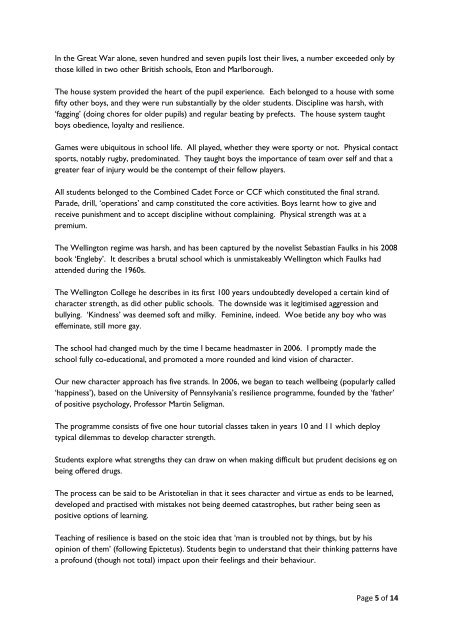priestley-2013-anthony-seldon
priestley-2013-anthony-seldon
priestley-2013-anthony-seldon
- No tags were found...
Create successful ePaper yourself
Turn your PDF publications into a flip-book with our unique Google optimized e-Paper software.
In the Great War alone, seven hundred and seven pupils lost their lives, a number exceeded only by<br />
those killed in two other British schools, Eton and Marlborough.<br />
The house system provided the heart of the pupil experience. Each belonged to a house with some<br />
fifty other boys, and they were run substantially by the older students. Discipline was harsh, with<br />
‘fagging’ (doing chores for older pupils) and regular beating by prefects. The house system taught<br />
boys obedience, loyalty and resilience.<br />
Games were ubiquitous in school life. All played, whether they were sporty or not. Physical contact<br />
sports, notably rugby, predominated. They taught boys the importance of team over self and that a<br />
greater fear of injury would be the contempt of their fellow players.<br />
All students belonged to the Combined Cadet Force or CCF which constituted the final strand.<br />
Parade, drill, ‘operations’ and camp constituted the core activities. Boys learnt how to give and<br />
receive punishment and to accept discipline without complaining. Physical strength was at a<br />
premium.<br />
The Wellington regime was harsh, and has been captured by the novelist Sebastian Faulks in his 2008<br />
book ‘Engleby’. It describes a brutal school which is unmistakeably Wellington which Faulks had<br />
attended during the 1960s.<br />
The Wellington College he describes in its first 100 years undoubtedly developed a certain kind of<br />
character strength, as did other public schools. The downside was it legitimised aggression and<br />
bullying. ‘Kindness’ was deemed soft and milky. Feminine, indeed. Woe betide any boy who was<br />
effeminate, still more gay.<br />
The school had changed much by the time I became headmaster in 2006. I promptly made the<br />
school fully co-educational, and promoted a more rounded and kind vision of character.<br />
Our new character approach has five strands. In 2006, we began to teach wellbeing (popularly called<br />
‘happiness’), based on the University of Pennsylvania’s resilience programme, founded by the ‘father’<br />
of positive psychology, Professor Martin Seligman.<br />
The programme consists of five one hour tutorial classes taken in years 10 and 11 which deploy<br />
typical dilemmas to develop character strength.<br />
Students explore what strengths they can draw on when making difficult but prudent decisions eg on<br />
being offered drugs.<br />
The process can be said to be Aristotelian in that it sees character and virtue as ends to be learned,<br />
developed and practised with mistakes not being deemed catastrophes, but rather being seen as<br />
positive options of learning.<br />
Teaching of resilience is based on the stoic idea that ‘man is troubled not by things, but by his<br />
opinion of them’ (following Epictetus). Students begin to understand that their thinking patterns have<br />
a profound (though not total) impact upon their feelings and their behaviour.<br />
Page 5 of 14


